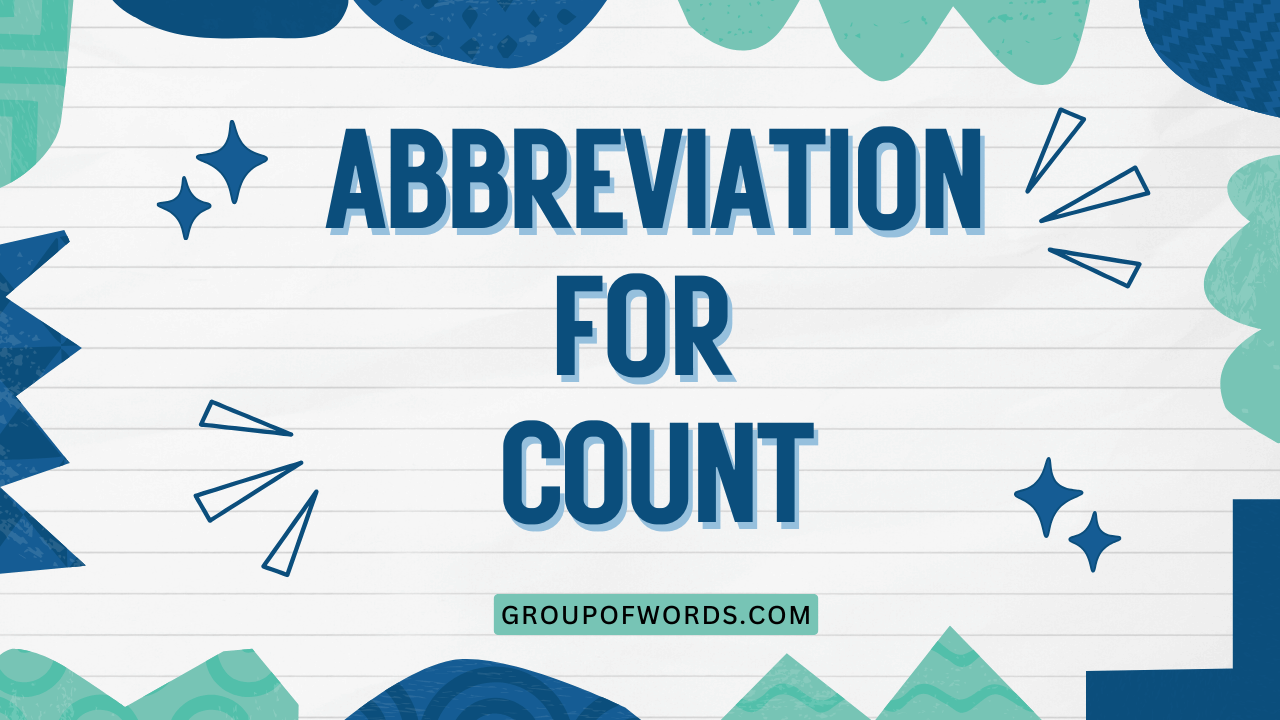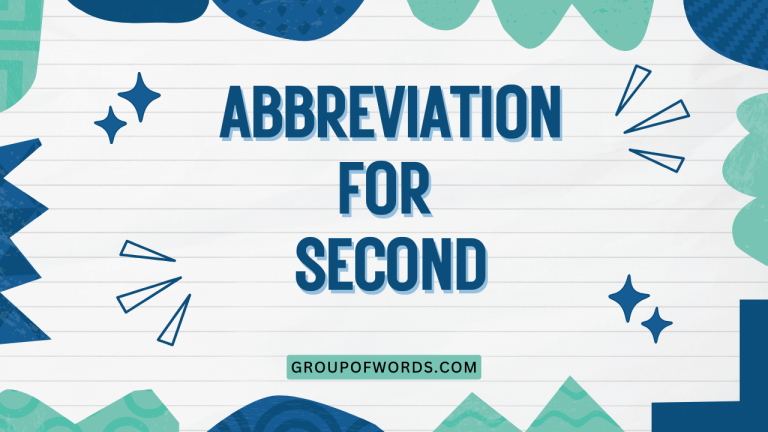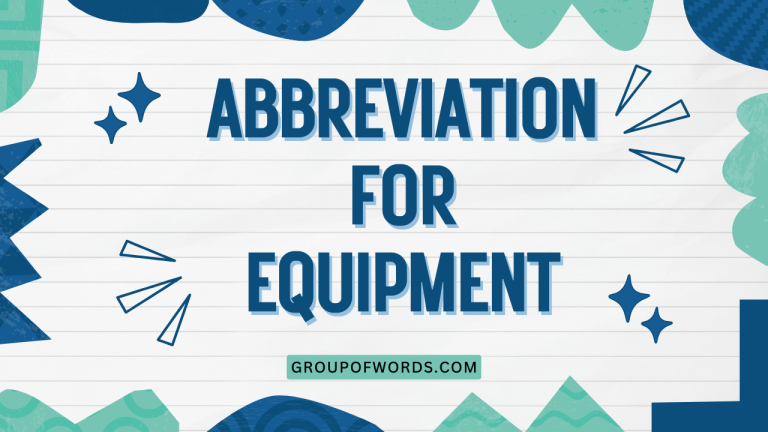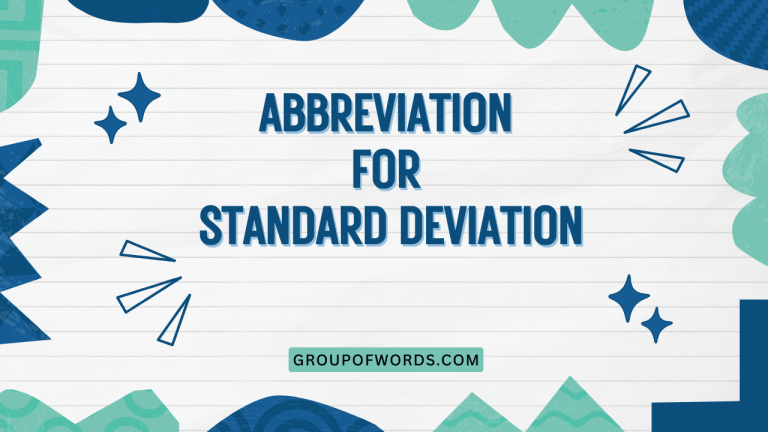Abbreviations for Count: A Comprehensive Guide
Understanding abbreviations for count is crucial for anyone looking to improve their English writing and communication skills. These abbreviations, such as ‘No.’, ‘Qty.’, and ‘Ea.’, are widely used in various contexts, from academic papers and business reports to everyday correspondence.
This comprehensive guide will delve into the definition, usage, and nuances of abbreviations for count, providing you with the knowledge and practice needed to use them correctly and confidently. Whether you’re a student, a professional, or simply an English language enthusiast, this article will help you master this essential aspect of English grammar.
Table of Contents
- Introduction
- Definition of Abbreviations for Count
- Structural Breakdown
- Types and Categories
- Examples of Abbreviations for Count
- Usage Rules for Abbreviations for Count
- Common Mistakes
- Practice Exercises
- Advanced Topics
- FAQ
- Conclusion
Definition of Abbreviations for Count
Abbreviations for count are shortened forms of words or phrases used to represent quantities, numbers, or enumerated items. These abbreviations serve to streamline writing, save space, and enhance clarity, especially in contexts where repeated use of the full word or phrase would be cumbersome.
They are commonly found in lists, tables, reports, and various forms of technical and business documentation.
The primary function of these abbreviations is to provide a concise way to indicate a quantity or number associated with a specific item or category. They help to avoid redundancy and improve the overall readability of the text.
For instance, instead of writing “number” repeatedly in a list, using “No.” streamlines the presentation. These abbreviations are classified as nouns, adjectives, or adverbs depending on their usage within a sentence.
Context plays a crucial role in understanding and using abbreviations for count. The specific abbreviation used can vary depending on the field, industry, or even the specific document’s style guide.
For example, “Qty.” is frequently used in inventory management, while “No.” is common in general listings and identification.
Structural Breakdown
The structure of abbreviations for count typically involves taking the initial letters of the full word or phrase, sometimes including key letters from the middle of the word to avoid ambiguity. For example, ‘No.’ is derived from the first two letters of ‘number,’ followed by a period.
Similarly, ‘Qty.’ is derived from the first three letters of ‘quantity.’ The use of periods is a common, though not universal, characteristic of these abbreviations.
The patterns in creating these abbreviations often follow a few key principles. Shortening is the most common, where the beginning of the word is used. Contraction involves removing letters from the middle of the word, like ‘Assn.’ for ‘Association’. Acronyms are formed from the initial letters of multiple words, though these are less common for simple counts. Understanding these patterns can help in recognizing and interpreting unfamiliar abbreviations.
Abbreviations for count can also be combined with numerical values to represent specific quantities. For example, “5 Nos.” indicates a count of five items.
The placement of the abbreviation relative to the number can vary depending on the specific abbreviation and the style guidelines being followed. Some abbreviations precede the number (e.g., “No. 5”), while others follow it (e.g., “5 Qty.”).
Types and Categories
General Count Abbreviations
General count abbreviations are used for basic enumeration and identification. These are some of the most commonly encountered abbreviations for count and are applicable in a wide range of contexts.
Examples include: No. (Number), Nos. (Numbers), Amt. (Amount), and Tot. (Total). These abbreviations are often used in lists, reports, and general documentation to indicate a specific count or quantity.
Measurement Count Abbreviations
Measurement count abbreviations are used to specify quantities related to dimensions, weight, volume, or other measurable attributes. These abbreviations are crucial in fields such as engineering, construction, and manufacturing.
Examples include: Wt. (Weight), Vol. (Volume), Len. (Length), Ht. (Height), and Dia. (Diameter). These abbreviations are often accompanied by specific units of measurement, such as inches, kilograms, or liters.
Item Count Abbreviations
Item count abbreviations are used to specify the number of individual items or units. These abbreviations are commonly used in inventory management, sales, and procurement.
Examples include: Qty. (Quantity), Ea. (Each), Pc. (Piece), Pcs. (Pieces), and Doz. (Dozen). These abbreviations are particularly useful in contexts where tracking and managing individual items is essential.
Statistical Count Abbreviations
Statistical count abbreviations are used in research, data analysis, and reporting to indicate frequencies, percentages, or other statistical measures. These abbreviations are essential for presenting quantitative data in a concise and standardized manner.
Examples include: Freq. (Frequency), Pct. (Percent), Avg. (Average), and SD (Standard Deviation). These abbreviations are often used in tables, graphs, and statistical analyses.
Examples of Abbreviations for Count
General Count Examples
General count abbreviations are versatile and used in various contexts. The table below provides examples of how these abbreviations are used in sentences.
| Abbreviation | Full Form | Example Sentence |
|---|---|---|
| No. | Number | Please write your name and address next to No. 5 on the list. |
| Nos. | Numbers | The winning lottery Nos. are 12, 23, 34, 45, 56, and 78. |
| Amt. | Amount | The Amt. due on the invoice is $500. |
| Tot. | Total | The Tot. cost of the project is estimated at $1 million. |
| Vol. | Volume | The Vol. of the container is 10 liters. |
| Len. | Length | The Len. of the table is 6 feet. |
| Ht. | Height | The Ht. of the building is 50 meters. |
| Dia. | Diameter | The Dia. of the pipe is 2 inches. |
| Qty. | Quantity | The Qty. of items in stock is 200. |
| Ea. | Each | The price is $10 Ea. |
| Pc. | Piece | I need one Pc. of cake. |
| Pcs. | Pieces | We need 5 Pcs. of wood for the project. |
| Doz. | Dozen | Please buy one Doz. eggs. |
| Freq. | Frequency | The Freq. of the events is weekly. |
| Pct. | Percent | The Pct. of students passing the exam is 80%. |
| Avg. | Average | The Avg. temperature is 25 degrees Celsius. |
| SD | Standard Deviation | The SD of the data set is 5. |
| Est. | Estimate | The Est. cost of the repairs is $300. |
| Max. | Maximum | The Max. capacity of the room is 50 people. |
| Min. | Minimum | The Min. age requirement is 18 years old. |
| Ref. | Reference | See Ref. section for more details. |
| Temp. | Temperature | The Temp. is expected to drop tonight. |
| Dist. | Distance | The Dist. between the two cities is 200 miles. |
| Approx. | Approximately | The project will take Approx. 3 months. |
| Incl. | Including | The price is $50, Incl. tax. |
| Excl. | Excluding | The price is $50, Excl. tax. |
| Fig. | Figure | See Fig. 1 for a diagram. |
Measurement Count Examples
Abbreviations related to measurements play a vital role in technical and scientific writing. The table below illustrates their usage.
| Abbreviation | Full Form | Example Sentence |
|---|---|---|
| Wt. | Weight | The Wt. of the package is 5 kg. |
| Vol. | Volume | The Vol. of the liquid is 1 liter. |
| Len. | Length | The Len. of the rope is 10 meters. |
| Ht. | Height | The Ht. of the tree is 15 feet. |
| Dia. | Diameter | The Dia. of the circle is 8 inches. |
| Sq. Ft. | Square Feet | The office space is 800 Sq. Ft. |
| Cu. M. | Cubic Meters | The Vol. of excavation is 50 Cu. M. |
| Gal. | Gallon | I need to buy 2 Gal. of milk. |
| Oz. | Ounce | This bottle contains 16 Oz. of juice. |
| Lb. | Pound | The package weighs 5 Lb. |
| In. | Inch | The board is 1 In. thick. |
| Ft. | Foot | The room is 12 Ft. wide. |
| Yd. | Yard | I need 3 Yd. of fabric. |
| Mm. | Millimeter | The screw is 5 Mm. in diameter. |
| Cm. | Centimeter | The plant grew 2 Cm. this week. |
| M. | Meter | The pool is 25 M. long. |
| Km. | Kilometer | The race is 5 Km. long. |
| Ml. | Milliliter | Add 10 Ml. of the solution. |
| L. | Liter | Buy 2 L. of soda. |
| Mg. | Milligram | The medicine contains 500 Mg. of acetaminophen. |
| G. | Gram | The recipe calls for 200 G. of flour. |
| Kg. | Kilogram | The package weighs 2 Kg. |
| Sec. | Second | Wait for 10 Sec. |
| Min. | Minute | The meeting will last 30 Min. |
| Hr. | Hour | The flight is 2 Hr. long. |
| Day | Day | The project will take 7 Days. |
Item Count Examples
Item count abbreviations are essential in inventory and sales contexts. The following table provides examples of their use.
| Abbreviation | Full Form | Example Sentence |
|---|---|---|
| Qty. | Quantity | Please specify the Qty. of each item you need. |
| Ea. | Each | The price is $20 Ea. |
| Pc. | Piece | I want one Pc. of cake. |
| Pcs. | Pieces | We need 10 Pcs. of wood for the fence. |
| Doz. | Dozen | Buy one Doz. eggs. |
| Pr. | Pair | I need a new Pr. of shoes. |
| Sets | Sets | We sell furniture in Sets. |
| Bdl. | Bundle | Please buy a Bdl. of firewood. |
| Ctn. | Carton | We ship the goods in Ctns. |
| Pkg. | Package | The Pkg. arrived today. |
| Roll | Roll | I need a Roll of tape. |
| Pad | Pad | Please give me a Pad of paper. |
| Box | Box | I bought a Box of chocolates. |
| Tube | Tube | I need a Tube of toothpaste. |
| Can | Can | Please buy a Can of soda. |
| Bottle | Bottle | I drank a Bottle of water. |
| Bag | Bag | I need a Bag of groceries. |
| Sack | Sack | Buy a Sack of potatoes. |
| Unit | Unit | Each Unit costs $5. |
| Item | Item | The store sells various Items. |
| Lot | Lot | We sell the land in Lots. |
| Series | Series | The book is part of a Series. |
| Edition | Edition | This is the latest Edition. |
| Copy | Copy | I need a Copy of the document. |
| Volume | Volume | This is Volume 1 of the series. |
| Issue | Issue | This is the latest Issue of the magazine. |
Usage Rules for Abbreviations for Count
Punctuation Rules
The use of periods in abbreviations for count can vary depending on the specific abbreviation and the style guide being followed. In general, abbreviations that are formed by shortening a word (e.g., “No.” for “Number”) typically include a period.
However, some abbreviations, especially those representing units of measurement (e.g., “kg” for “kilogram”), often omit the period. Consistency is key; choose a style and adhere to it throughout your document.
When an abbreviation ends a sentence, the period serves as both the abbreviation’s period and the sentence’s period. There is no need to add an additional period.
If the abbreviation is followed by a question mark or exclamation point, those punctuation marks should be added after the period.
Capitalization Rules
The capitalization of abbreviations for count depends on the context and the style guide being used. In general, if the full word or phrase is capitalized, the abbreviation should also be capitalized.
For example, if you are referring to a specific numbered item in a list, you might capitalize “No.” However, in running text, lowercase abbreviations are often preferred unless they begin a sentence or are part of a proper noun.
For abbreviations that consist of multiple letters, the capitalization should match the capitalization of the full words. For example, “SD” for “Standard Deviation” is typically capitalized because both words are capitalized in the full phrase.
Contextual Rules
The choice of abbreviation for count should be appropriate for the context in which it is being used. In formal writing, it is often preferable to spell out the full word or phrase, especially if the abbreviation is not widely known or if the document is intended for a general audience.
In technical or business writing, where space is often limited and abbreviations are commonly understood, using abbreviations can enhance clarity and efficiency.
Avoid using abbreviations excessively, as this can make your writing difficult to read. Use them judiciously, and always ensure that the meaning is clear from the context.
If there is any doubt, spell out the full word or phrase.
Common Mistakes
One common mistake is inconsistent use of periods. For example, sometimes writing “No” and other times “No.”.
Always maintain consistency within a single document. Another frequent error is using the wrong abbreviation for the intended meaning.
For instance, using “Amt.” when “Qty.” is more appropriate. Misunderstanding capitalization is also common, such as capitalizing abbreviations in running text when they should be lowercase.
Incorrect: The qty. of items is 10.
Correct: The Qty. of items is 10.
Incorrect: There are 5 no. of apples.
Correct: There are 5 Nos. of apples.
Incorrect: The amount due is 500 amt.
Correct: The amount due is 500 Amt.
Incorrect: The total cost is tot 1000.
Correct: The total cost is Tot. 1000.
Incorrect: The weight is 5 kg.
Correct: The Wt. is 5 kg.
Practice Exercises
Exercise 1: Identifying Correct Abbreviations
Choose the correct abbreviation for the word or phrase in parentheses.
| Question | Options | Answer |
|---|---|---|
| The (number) of students is 25. | a) No. b) Num. c) N. | a) No. |
| The (quantity) of items is 100. | a) Quan. b) Qty. c) Quant. | b) Qty. |
| The (amount) due is $50. | a) Amt. b) Amnt. c) Amo. | a) Amt. |
| The (total) cost is $1000. | a) Tot. b) Ttl. c) To. | a) Tot. |
| The (weight) of the package is 5 kg. | a) Wt. b) Weg. c) We. | a) Wt. |
| The (volume) of the liquid is 1 liter. | a) Vol. b) Vlm. c) Vo. | a) Vol. |
| The (length) of the rope is 10 meters. | a) Len. b) Lgth. c) Le. | a) Len. |
| The (height) of the tree is 15 feet. | a) Ht. b) Hei. c) Hg. | a) Ht. |
| The (diameter) of the circle is 8 inches. | a) Dia. b) Diam. c) Di. | a) Dia. |
| The price is $10 (each). | a) Ea. b) Ec. c) E. | a) Ea. |
Exercise 2: Using Abbreviations in Sentences
Rewrite the following sentences using appropriate abbreviations for count.
| Question | Answer |
|---|---|
| The number of participants is twenty-five. | The No. of participants is 25. |
| The quantity of products in stock is one hundred. | The Qty. of products in stock is 100. |
| The amount owed on the invoice is five hundred dollars. | The Amt. owed on the invoice is $500. |
| The total expense for the project is one thousand dollars. | The Tot. expense for the project is $1000. |
| The weight of the package is five kilograms. | The Wt. of the package is 5 kg. |
| The volume of the container is one liter. | The Vol. of the container is 1 liter. |
| The length of the table is six feet. | The Len. of the table is 6 feet. |
| The height of the building is fifty meters. | The Ht. of the building is 50 meters. |
| The diameter of the pipe is two inches. | The Dia. of the pipe is 2 inches. |
| The price is ten dollars for each. | The price is $10 Ea. |
Exercise 3: Correcting Incorrect Abbreviations
Identify and correct the incorrect abbreviations in the following sentences.
| Question | Answer |
|---|---|
| The nmbr of items is 10. | The No. of items is 10. |
| The qnty of goods is 50. | The Qty. of goods is 50. |
| The amnt due is $200. | The Amt. due is $200. |
| The ttl cost is $800. | The Tot. cost is $800. |
| The wght of the box is 2 kg. | The Wt. of the box is 2 kg. |
| The vol of water is 2 liters. | The Vol. of water is 2 liters. |
| The lngth of the wire is 5 m. | The Len. of the wire is 5 m. |
| The hght of the wall is 3 m. | The Ht. of the wall is 3 m. |
| The dmtr of the circle is 4 cm. | The Dia. of the circle is 4 cm. |
| The price is $5 ec. | The price is $5 Ea. |
Advanced Topics
International Variations
Abbreviations for count can vary across different English-speaking countries and languages. For example, the abbreviation for “number” in some European countries might be “Nr.” instead of “No.” It’s essential to be aware of these variations, especially when writing for an international audience.
Different style guides, such as the Chicago Manual of Style or the AP Stylebook, may also have specific preferences for abbreviations. Always consult the relevant style guide when preparing a document for publication or professional use.
Formal vs. Informal Usage
In formal writing, it is generally preferable to spell out the full word or phrase rather than using an abbreviation. Abbreviations are more commonly used in informal writing, such as emails, memos, and notes.
However, even in informal writing, clarity should always be the primary concern. If there is any doubt that the reader will understand the abbreviation, it is best to spell out the full word or phrase.
In academic writing, avoid using abbreviations excessively. Use them sparingly and only when they are widely accepted and understood within your field of study.
Always define any less common abbreviations the first time you use them.
FAQ
- What is the difference between an abbreviation and an acronym?
An abbreviation is a shortened form of a word or phrase, while an acronym is a word formed from the initial letters of a series of words. For example, “No.” is an abbreviation for “Number,” while “NASA” is an acronym for “National Aeronautics and Space Administration.”
- When should I use a period after an abbreviation?
Generally, use a period after abbreviations formed by shortening a word (e.g., “No.” for “Number,” “Amt.” for “Amount”). However, abbreviations for units of measurement (e.g., “kg” for “kilogram,” “m” for “meter”) often omit the period. Consistency is key; choose a style and adhere to it throughout your document.
- Is it okay to use abbreviations in formal writing?
In formal writing, it’s generally better to spell out words and phrases fully, especially if the abbreviation isn’t widely known. Use abbreviations sparingly and only when they enhance clarity and efficiency. Always define any less common abbreviations the first time you use them.
- How do I pluralize abbreviations for count?
Most abbreviations for count are pluralized by adding an “s” to the end. For example, the plural of “No.” is “Nos.,” and the plural of “Pc.” is “Pcs.” However, some abbreviations, such as those for units of measurement, do not change in the plural (e.g., “5 kg,” not “5 kgs”).
- What if I’m not sure which abbreviation to use?
When in doubt, spell out the full word or phrase. Clarity is always the most important consideration. If you’re unsure whether an abbreviation is appropriate for your audience, it’s better to err on the side of caution and use the full form.
- Are abbreviations case-sensitive?
Yes, abbreviations can be case-sensitive. The capitalization should generally match the capitalization of the full word or phrase. For example, “SD” for “Standard Deviation” is typically capitalized, while “no.” for “number” is typically lowercase.
- How do I handle abbreviations at the end of a sentence?
When an abbreviation ends a sentence, use only one period to serve both as the abbreviation’s period and the sentence’s period. Do not add an additional period.
- Where can I find a comprehensive list of abbreviations?
Dictionaries and style guides (such as the Chicago Manual of Style or the AP Stylebook) often include lists of common abbreviations. Online resources, such as abbreviation dictionaries and style guide websites, can also be helpful.
Conclusion
Mastering abbreviations for count is an essential skill for effective communication in English. By understanding the definitions, structural breakdown, types, usage rules, and common mistakes associated with these abbreviations, you can enhance the clarity and conciseness of your writing.
Remember to consider the context, audience, and style guide when choosing and using abbreviations. Consistent practice and attention to detail will help you confidently and accurately use abbreviations for count in various settings.
As a final tip, create a personal reference list of commonly used abbreviations in your field or area of interest. Regularly review and update this list to stay current with evolving language conventions.
With consistent effort, you’ll be able to wield abbreviations for count with proficiency and precision, making your writing more effective and impactful.






